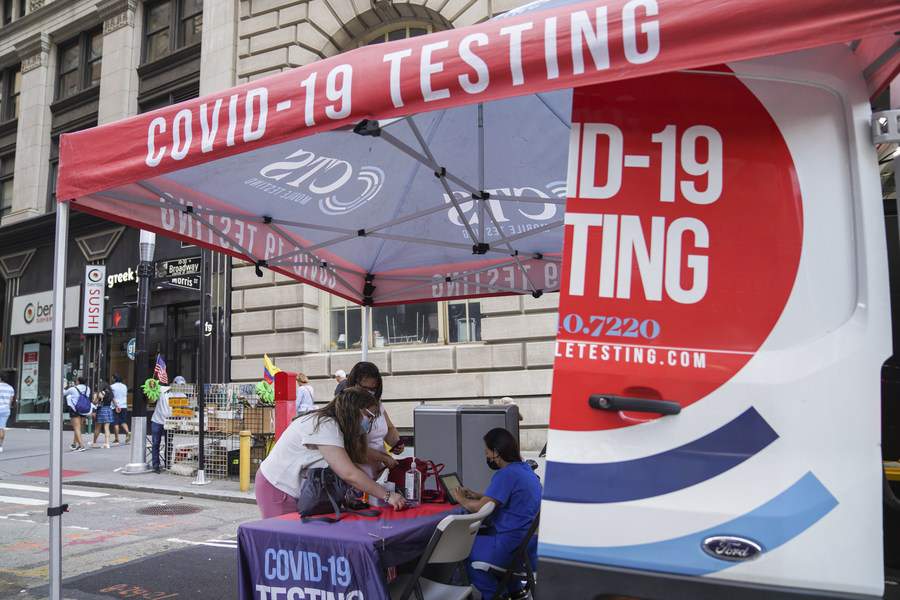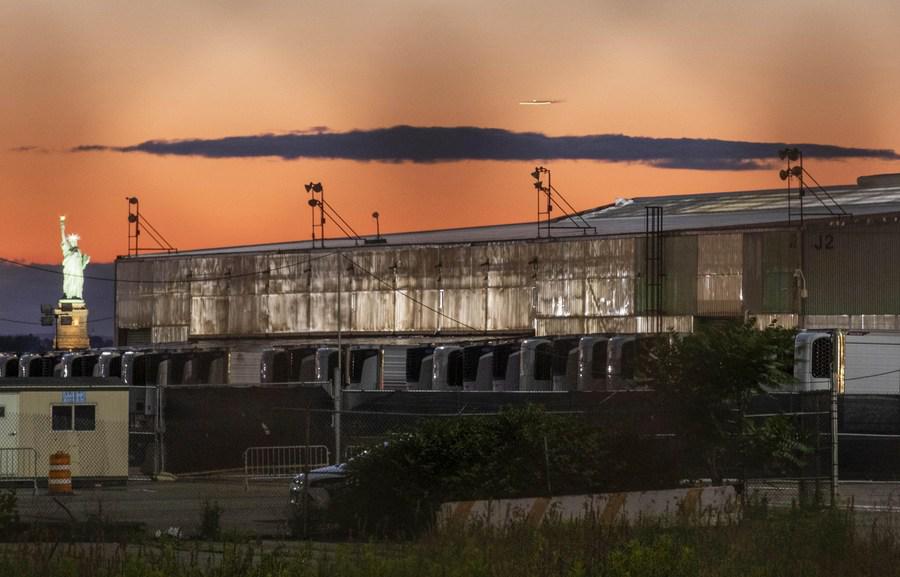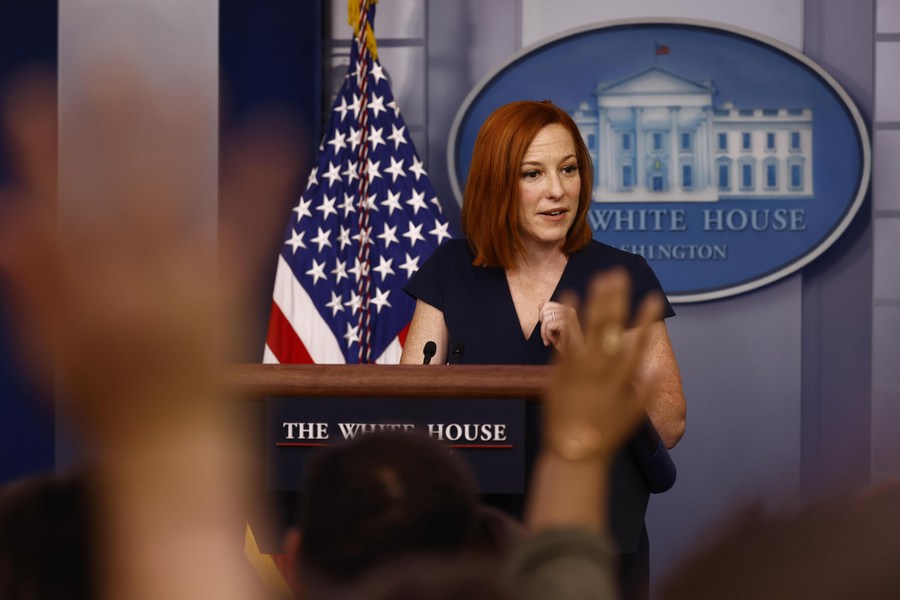COVID-19 runs wild in U.S., peak yet to be seen

People register for COVID-19 test at a mobile testing site in New York, the United States, Sept. 6, 2021.(Xinhua/Wang Ying)
Altogether 650,532 Americans have died from COVID-19 as of Wednesday, averaging more than 1,100 deaths per day since the first coronavirus death was reported in the United States, according to Johns Hopkins University. New Jersey, Mississippi and New York are among states with the highest coronavirus death rates.
NEW YORK, Sept. 8 (Xinhua) -- While the federal government sharpens new strategy to fight the COVID-19 pandemic, the return of unvaccinated school children to classrooms, cold weather in the northern states and the upcoming holiday season could give the coronavirus new opportunities to spread in the United States, further fueling the cases and hospitalizations consistently on rise.
"I don't know if we've peaked for all time, but the wave that was currently ongoing seems to have crested and is falling in some states but is rising in others," Andrew Noymer, an infectious disease epidemiologist and demographer at the University of California, Irvine, was quoted on Wednesday by The Wall Street Journal as saying.
According to The New York Times, the 7-day average of confirmed cases of the pandemic stood at 152,393 nationwide on Tuesday, with its 14-day change striking a 1-percent increase. COVID-19-related deaths were 1,499 on Tuesday, with the 14-day change realizing a 34-percent rise.
STATES WOUNDED MOST
Altogether 650,532 Americans have died from COVID-19 as of Wednesday, averaging more than 1,100 deaths per day since the first coronavirus death was reported in this country, according to data compiled by Johns Hopkins University. Some states have sustained especially large death tolls.
New Jersey, which faced a brutal early surge of COVID-19 infections in spring 2020, has the nation's highest coronavirus death rate, totaling 303 fatalities per 100,000 residents since the start of the pandemic last year, according to the U.S. Centers for Disease Control and Prevention (CDC).

Refrigerated trailers are seen at a temporary morgue in Brooklyn, New York, the United States, June 15, 2021. (Xinhua/Wang Ying)
Mississippi has the second-highest death rate, at 291 per 100,000 people, a toll driven partly by a recent wave of infections that's left Mississippi with the nation's third-highest rate of new cases per day in the last week.
New York has suffered 279 deaths per 100,000, the country's third-highest rate. The death rate statistics published by the CDC list New York City (403 deaths per 100,000) separately from the rest of New York State (184).
Another five states have death rates above 250 per 100,000 residents: Louisiana (273), Massachusetts (265), Arizona (261), Rhode Island (261) and Alabama (253).
Some 15 other states have suffered more than 200 deaths per 100,000 residents, including larger states like Pennsylvania (221), Florida (218), Michigan (217), Georgia (217) and Illinois (210).
BLOCK AND SHORTAGE
One big news related with the pandemic on Wednesday was that Florida's Leon County Circuit Judge John Cooper agreed to set aside a stay on his ruling and blocked the Sunshine State's mask mandate ban, effective immediately. With the motion to vacate the stay granted, Republican Governor Ron DeSantis' ban, which requires districts to offer parental opt-outs or face a financial penalty, is now on hold for at least the duration of a forthcoming court challenge in appellate court.
The back-and-forth legal battle began after Judge Cooper found the governor's ban unlawful last month following a lawsuit brought by pro-mask parents. Cooper ruled a 2021 law, the Parents' Bill of Rights, protecting a district's choice to install protections like a mask mandate provided it meets certain criteria if challenged.

Guests dine outside in Coral Gables near Miami, Florida, the United States, Aug. 11, 2021. (Xinhua/Monica McGivern)
DeSantis has maintained his executive order and connected administrative rules are lawful, continuing to defend the action as protecting a parent's right to choose what's best for the health and wellbeing of their children.
On Tuesday, northwestern U.S. state Idaho's public health leaders announced that they activated "crisis standards of care," allowing health care rationing for the state's northern hospitals because there are more coronavirus patients than the institutions can handle.
The state health agency cited "a severe shortage of staffing and available beds in the northern area of the state caused by a massive increase in patients with COVID-19 who require hospitalization," reported NBC.
The Idaho Department of Health warned residents that they may not get the care they would normally expect if they need to be hospitalized. The move came as the state's confirmed coronavirus cases skyrocketed in recent weeks. Idaho has one of the lowest vaccination rates in the United States.
STRATEGY AND MILESTONE
U.S. President Joe Biden on Thursday will present a six-pronged strategy intended to fight the spread of the highly contagious coronavirus Delta variant and increase U.S. COVID-19 vaccinations.
White House spokeswoman Jen Psaki told reporters on Tuesday that the strategy would be "working across the public and private sectors to help continue to get the pandemic under control."

White House Press Secretary Jen Psaki speaks during a press briefing at the White House in Washington, D.C., the United States, on June 8, 2021. (Photo by Ting Shen/Xinhua)
Asked about possible new mandates, the spokeswoman acknowledged that the federal government cannot broadly mandate that Americans get vaccinated, adding that "we need to continue to take more steps to make sure school districts are prepared and make sure communities across the country are prepared."
Also on Tuesday, White House COVID-19 Data Director Cyrus Shahpar tweeted that three-fourths of U.S. adults have been vaccinated with at least one dose of the COVID-19 vaccine.
From Sunday through Tuesday, 1.51 million doses were administered, with 681,000 newly vaccinated and 105,000 additional doses, he said, noting that there was "as usual, lower reporting over the holiday weekend" of Labor Day.
The United States reached the 75 percent threshold about a month after hitting 70 percent. Previously, Biden had hoped to achieve the 70 percent mark by July 4.
Photos
Related Stories
- Politics has no place in COVID-19 origins tracing, says WHO chief scientist
- Chinese megacity ramps up efforts to curb COVID-19 resurgence
- Zhang Boli revisits makeshift hospital in Wuhan
- Turkey's exhibition shows masks as new reality of life amid pandemic
- Huanan seafood market may not be site of earliest COVID-19 outbreak: WHO-China team
Copyright © 2021 People's Daily Online. All Rights Reserved.










